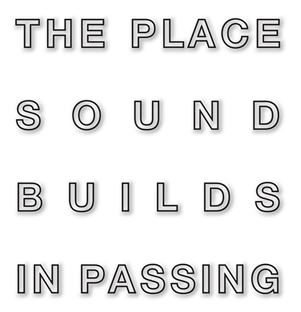TROND LOSSIUS
The Place Sound Builds in Passing
Trond Lossius åpner sin lydinstallasjon i samspill med Bergen Barokk på 3,14.
31.10.-09.11.14
Fredag 31.10.
> 17.00 Åpning
>
17.30 Bergen Barokk
Lørdag 1.11.
>
14.00 Bergen Barokk
> 15.30 Trekantsambandet
> 17.00 Bergen Barokk, til ca 18.00
Søndag 2.11.
>
14.00 Bergen Barokk
> 15.30 Jostein Gundersen og Hans Knut Sveen
> 17.00 Bergen Barokk, til ca 18.00
OBS! ÅPNINGSTIDER LØRDAG 1. & SØNDAG 2. NOV.: kl. 14.00-18.00
31. oktober åpner Trond Lossius sin lydinstallasjon ”The place sound builds in passing” i samspill med Bergen Barokk på Stiftelsen 3,14 i Vågsbunnen. Gjennom Bergen kirkeautunnale og uken etter vil innspilt lyd fra forskjellige uteområder flyttes inn i galleriet og bli lydomgivelser i et rom som har sin egen historie, sitt eget lydmiljø og en særegen akustikk. I korte eller lengre intervall vil utøvere spille opp mot dette, gjennom musikalsk eller visuell presentasjon, elektronisk eller akustisk. Fra tirsdag 4. november vil de skiftende lydlandskapene gå i dialog med videoarbeid av Jeremy Welsh.
De senere årene har Trond Lossius gjort lydopptak i ulike utemiljø. Han benytter en Ambisonic mikrofon som fanger opp lyd fra alle retninger på en slik måte at opptakene kan avspilles i surround. Heller enn å være opptak av enkeltlyder og lydkilder, er dette opptak av lydomgivelser, og opptakene gir en fornemmelse av sted. Mange som arbeider med feltopptak fokuserer enten på det urbane, i en forlengelse av en futuristisk ”art of noise” tradisjon, eller gjør opptak i uberørt natur. Trond Lossius sine opptak er hovedsaklig gjort i bydeler og forsteder. Dette er steder som hverken er utpreget urbane eller uberørt natur, men hvor lydbildet i stedet blir en ”skitten” antroposcenisk miks. Disse miljøene fremstår mange ganger som hverdagslige, banale og anonyme, og i lydopptakene er det få markører som gjør det mulig å identifisere det enkelte stedet. I stedet preges opptakene av auditive fellesnevnere som går igjen fra et sted til et annet, fra en bydel til en annen, og fra et land til et annet. Lydomgivelsenes kvaliteter er mer tidsspesifikke enn geografisk bestemt. Opptakene dokumenterer hvordan lydomgivelsene påvirkes av trafikk og andre kommunikasjonsmidler, og hvordan disse fremkomstmidlene har blitt en grunnleggende premiss for organiseringen av det moderne samfunnet.
Samtidig skifter lyden karakter når den lyttes til løsrevet fra visuell informasjon om stedet og lydkildene. Mange lydkilder blir vanskelige å identifisere og kategorisere, og nye koblinger og fellesnevnere oppstår. Parallelt med immersiv lytting til landskapene hvor opptakene er gjort, innbyr opptakene også til en fenomenologisk redusert lytting til lyden i seg selv, som lydobjekter, i tråd med tenkning innen fransk akusmatisk musikk. I lydinstallasjonen vil bearbeiding og abstraherende prosessering av lydopptakene bidra til å fremheve og undersøke disse kvalitetene. Samtidig vil lydinstallasjon være tilpasset stedet hvor den presenteres, og gå i dialog med akustikken, arkitekturen og lydomgivelsene ved Stiftelsen 3,14.
Arbeidet med lydinstallasjonen er prosessorientert. Trond Lossius vil bruke visningsperioden til aktiv utforsking av lydmaterialet og undersøke hvordan det kan brukes og lyttes til på ulike måter. Lydinstallasjonen vil derfor forandre seg fra dag til dag, og inngå i samspill med musikkutøvere i improvisasjoner. Fra tirsdag 4. november vil video komme inn som en viktig del av installasjonen. I denne siste delen av prosjektperioden vil hovedfokus ligge på audiovisuelle feltopptak som Trond Lossius og Jeremy Welsh har gjort sammen på Vestlandet. Dette er en første utprøving av materiale fra et pågående samarbeidsprosjekt. Disse utforskingene vil fortsette senere i høst i en utstilling ved Visningsrommet USF som Jeremy Welsh står i spissen for, og hvor Trond Lossius er invitert inn som en av flere deltagere.
Ansvarlige for produksjonen er Bergen Barokk og Trond Lossius som tidligere har samarbeidet i liknende prosjekt, - ”Lines Converging at a Distance”, under jubileet i Håkonshallen i 2011 og i konsertform som ”Brudd. Flate.” under Holbergdagene samme år. Produksjonen skjer i samarbeid med Stiftelsen 3,14, Bergen kirkeautunnale og Ekkofestivalen, med støtte fra Bergen kommune, Norsk kulturråd og BEK - Bergen senter for elektronisk kunst.
Du kan lese mer om Trond Lossius sitt arbeid med feltopptak i en artikkel som nylig ble publisert i Journal for Artistic Research.[1]
Trond Lossius har utdanning i geofysikk fra Universitetet i Bergen, komposisjon ved Griegakademiet, Institutt for musikk, UiB, og har vært kunststipendiat ved KHIB. Han undersøker forhold mellom lyd, rom og sted i installasjoner og andre tverrkunstneriske prosjekter. Han er tilknyttet BEK - Bergen senter for elektronisk kunst, hvor han arbeider med kunstnerisk utviklingsarbeid, prosjektkoordinering, programvareutvikling og forskning.[2]
[1] http://www.researchcatalogue.net/view/48986/65823
[2] http://www.trondlossius.no=
Bergen Barokk regnes som et av Norges ledende tidligmusikk-ensembler, og ble stiftet av Frode Thorsen og Hans Knut Sveen i 1994. Foruten konserter i inn- og utland, har ensemblet spilt inn musikk av både kjente og tildels lite kjente komponister, som Arcangelo Corelli, Francesco Maria Veracini, Francesco Barsanti, Georg von Bertouch, Benedetto Marcello, Georg Friedrich Händel, Johann Christoph Pepusch, Jacques Paisible, Gottfried Finger, Johann Jakob Froberger og andre. I 2006 gav Bergen Barokk den første CDen i en planlagt komplett utgave av alle de 72 kantatene i Georg Philipp Telemanns Harmonischer Gottes-Dienst (1725-26). Femte av i alt 13 CDer i serien ble sluppet i 2013. Bergen Barokk er støttet av Bergen kommune, Norsk kulturråd og Universitetet i Bergen /v. Griegakademiet.
Jeremy Welsh er billedkunstner og professor ved Kunstakademiet i Trondheim, NTNU. Hans kunstnerisk arbeid omfatter video/film, foto og installasjon, ofte realisert i samarbeid med andre kunstnere og musikere. Til prosjektet på 3,14 skal han bidra med HD videoopptak spillt inn på Vestlandet sommer og høst 2014 under flere felles reiser med Trond Lossius. De siste årene har mye av Welsh’s arbeid vært fokusert på vår opplevelse og oppfatning av sted (Place) - et tema han har utforsket både som kunstner, lærer og kurator, med blant annet utstillingen “Tracking/Tracing” som fant sted på 3,14 i 2012. |





























